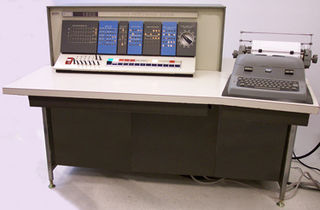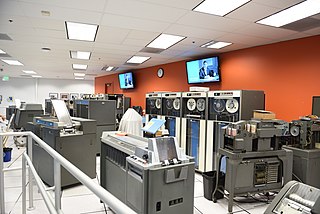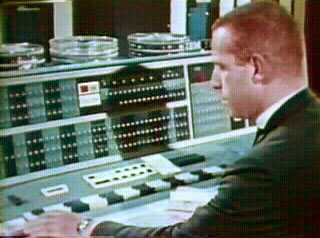In processor design, microcode serves as an intermediary layer situated between the central processing unit (CPU) hardware and the programmer-visible instruction set architecture of a computer, also known as its machine code. It consists of a set of hardware-level instructions that implement the higher-level machine code instructions or control internal finite-state machine sequencing in many digital processing components. While microcode is utilized in Intel and AMD general-purpose CPUs in contemporary desktops and laptops, it functions only as a fallback path for scenarios that the faster hardwired control unit is unable to manage.

The IBM System/360 (S/360) is a family of mainframe computer systems announced by IBM on April 7, 1964, and delivered between 1965 and 1978. System/360 was the first family of computers designed to cover both commercial and scientific applications and a complete range of applications from small to large. The design distinguished between architecture and implementation, allowing IBM to release a suite of compatible designs at different prices. All but the only partially compatible Model 44 and the most expensive systems use microcode to implement the instruction set, featuring 8-bit byte addressing and fixed-point binary, fixed-point decimal and hexadecimal floating-point calculations. The System/360 family introduced IBM's Solid Logic Technology (SLT), which packed more transistors onto a circuit card, allowing more powerful but smaller computers.

The IBM System/370 (S/370) is a range of IBM mainframe computers announced as the successors to the System/360 family on June 30, 1970. The series mostly maintains backward compatibility with the S/360, allowing an easy migration path for customers; this, plus improved performance, were the dominant themes of the product announcement.

The IBM 1620 was a model of scientific minicomputer produced by IBM. It was announced on October 21, 1959, and was then marketed as an inexpensive scientific computer. After a total production of about two thousand machines, it was withdrawn on November 19, 1970. Modified versions of the 1620 were used as the CPU of the IBM 1710 and IBM 1720 Industrial Process Control Systems.

The IBM 1401 is a variable-wordlength decimal computer that was announced by IBM on October 5, 1959. The first member of the highly successful IBM 1400 series, it was aimed at replacing unit record equipment for processing data stored on punched cards and at providing peripheral services for larger computers. The 1401 is considered by IBM to be the Ford Model-T of the computer industry due to its mass appeal. Over 12,000 units were produced and many were leased or resold after they were replaced with newer technology. The 1401 was withdrawn on February 8, 1971.

The IBM 650 Magnetic Drum Data-Processing Machine is an early digital computer produced by IBM in the mid-1950s. It was the first mass-produced computer in the world. Almost 2,000 systems were produced, the last in 1962, and it was the first computer to make a meaningful profit. The first one was installed in late 1954 and it was the most popular computer of the 1950s.

The IBM 7090 is a second-generation transistorized version of the earlier IBM 709 vacuum tube mainframe computer that was designed for "large-scale scientific and technological applications". The 7090 is the fourth member of the IBM 700/7000 series scientific computers. The first 7090 installation was in December 1959. In 1960, a typical system sold for $2.9 million or could be rented for $63,500 a month.

The IBM 7030, also known as Stretch, was IBM's first transistorized supercomputer. It was the fastest computer in the world from 1961 until the first CDC 6600 became operational in 1964.

The IBM 700/7000 series is a series of large-scale (mainframe) computer systems that were made by IBM through the 1950s and early 1960s. The series includes several different, incompatible processor architectures. The 700s use vacuum-tube logic and were made obsolete by the introduction of the transistorized 7000s. The 7000s, in turn, were eventually replaced with System/360, which was announced in 1964. However the 360/65, the first 360 powerful enough to replace 7000s, did not become available until November 1965. Early problems with OS/360 and the high cost of converting software kept many 7000s in service for years afterward.
A processor register is a quickly accessible location available to a computer's processor. Registers usually consist of a small amount of fast storage, although some registers have specific hardware functions, and may be read-only or write-only. In computer architecture, registers are typically addressed by mechanisms other than main memory, but may in some cases be assigned a memory address e.g. DEC PDP-10, ICT 1900.

The IBM 305 RAMAC was the first commercial computer that used a moving-head hard disk drive for secondary storage. The system was publicly announced on September 14, 1956, with test units already installed at the U.S. Navy and at private corporations. RAMAC stood for "Random Access Method of Accounting and Control", as its design was motivated by the need for real-time accounting in business.
In computing, a word is the natural unit of data used by a particular processor design. A word is a fixed-sized datum handled as a unit by the instruction set or the hardware of the processor. The number of bits or digits in a word is an important characteristic of any specific processor design or computer architecture.

The IBM System/360 Model 67 (S/360-67) was an important IBM mainframe model in the late 1960s. Unlike the rest of the S/360 series, it included features to facilitate time-sharing applications, notably a Dynamic Address Translation unit, the "DAT box", to support virtual memory, 32-bit addressing and the 2846 Channel Controller to allow sharing channels between processors. The S/360-67 was otherwise compatible with the rest of the S/360 series.

A decimal computer is a computer that represents and operates on numbers and addresses in decimal format – instead of binary as is common in most modern computers. Some decimal computers had a variable word length, which enabled operations on relatively large numbers.
This timeline of binary prefixes lists events in the history of the evolution, development, and use of units of measure that are germane to the definition of the binary prefixes by the International Electrotechnical Commission (IEC) in 1998, used primarily with units of information such as the bit and the byte.
An instruction set architecture (ISA) is an abstract model of a computer, also referred to as computer architecture. A realization of an ISA is called an implementation. An ISA permits multiple implementations that may vary in performance, physical size, and monetary cost ; because the ISA serves as the interface between software and hardware. Software that has been written for an ISA can run on different implementations of the same ISA. This has enabled binary compatibility between different generations of computers to be easily achieved, and the development of computer families. Both of these developments have helped to lower the cost of computers and to increase their applicability. For these reasons, the ISA is one of the most important abstractions in computing today.
The IBM System/360 architecture is the model independent architecture for the entire S/360 line of mainframe computers, including but not limited to the instruction set architecture. The elements of the architecture are documented in the IBM System/360 Principles of Operation and the IBM System/360 I/O Interface Channel to Control Unit Original Equipment Manufacturers' Information manuals.
ICT 1900 was a family of mainframe computers released by International Computers and Tabulators (ICT) and later International Computers Limited (ICL) during the 1960s and 1970s. The 1900 series was notable for being one of the few non-American competitors to the IBM System/360, enjoying significant success in the European and British Commonwealth markets.

The IBM System/360 Model 44 is a specialized member of the IBM System/360 family, with a variant of the System/360 computer architecture, designed for scientific computing, real-time computing, process control and numerical control (NC).

The SDS 9 Series computers are a backward compatible line of transistorized computers produced by Scientific Data Systems in the 1960s and 1970s. This line includes the SDS 910, SDS 920, SDS 925, SDS 930, SDS 940, and the SDS 945. The SDS 9300 is an extension of the 9xx architecture. The 1965 SDS 92 is an incompatible 12-bit system built using monolithic integrated circuits.












